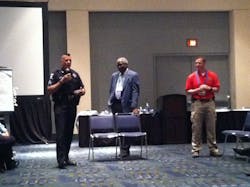During the 2016 American Public Transportation Association (APTA) Bus & Paratransit Conference there was an open discussion hosted on concealed and open carry firearm laws. Firearm carry laws differ from state to state, but the biggest highlight was educating operators on those laws — to ensure that they properly address the situation.
Sgt. Charles Rappleyea, the police liaison for Charlotte Area Transit System (CATS) said that Charlotte has a no carry law for all public transit. When they do get a call about someone with a weapon he said that they rarely have a problem.
“When we do, they’re often criminals,” said Rappleyea. “Everyone that we’ve encountered with a concealed permit, we haven’t had a problem.”
Whereas in Dallas, Texas, they have an open carry law. James Spiller, the chief of police and emergency management for Dallas Area Rapid Transit (DART), explained for people with open carry licenses — their gun must be in a holster. With the law it was important to educate the public on the rules.
“In Texas, if they are open carry, as a police officer I can’t just walk up and ask them if they have a licence without probable cause,” explained Spiller.
Which raises the question, how do transit operators determine if the person boarding their bus or train with a firearm is legally authorized to do so?
“They have a button, if they’re uncomfortable they can press the button to show ‘hey someone has boarded with a gun’.”
While Spiller said that DART has not had any serious calls, they have had three where the operator felt uncomfortable.
“The operator says ‘watch my back’ and we bring it up on the security camera,” Spiller said.
Maurice Bell, assistant vice president - Bus Operations, DART, said that they use Trapeze, the system has a 1-2-3 radio response and operators have two options. They can select the code OCCM, which means that they would like to be monitored, or OCTR, which means they would like to request assistance. Their request is sent directly to dispatch and from there dispatch can pass it along to the police. Dispatch is also able to talk with the operator when the cameras are being monitored.
“Operators remaining calm is the first step, but we also tell them if this individual is acting in a particular way, that is when they are told to respond. As soon as they see something, they need to pull over and both they and the customers need to leave. We don’t want anyone in that situation,” said Bell.
Bret Brooks, chief operating officer for Gray Ram Tactical LLC, stressed the importance of training operators not to overreact. Brooks explained that they can’t have operators worried if someone is reaching for their wallet — and also for them to understand the state-by-state laws. Brooks said that in many cases it is not a firearm, but another weapon that is used.
“We had a person assault and hijack a bus operator with a ski,” said Brooks.
The question was raised in the session about rural transportation systems that may not have the same technology.
“I recommend having an arrangement with the local sheriff to agree what rules are in accordance with the law,” said Spiller.
Brooks added, “Chances are, if you work in a rural area, drivers know everyone. They can pick up on a change of mind and behavior.”

